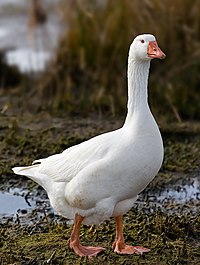Domestic goose
| Domestic goose | |
|---|---|

| |
| An trinomial name A. anser domesticus
| |

| |
| A Chinese goose, a breed derived from the swan goose (Anser cygnoides). It has the trinomial name A. cygnoides domesticus | |
Domesticated
| |
| Scientific classification | |
| Kingdom: | |
| Phylum: | |
| Class: | Aves |
| Order: | |
| Family: | |
| Subfamily: | |
| Genus: | |
| Species: | |
| Subspecies: | A. a. domesticus & A. c. domesticus
|
| Binomial name | |
| Anser anser domesticus & Anser cygnoides domesticus Linnaeus , 1758 | |
A domestic goose is a
Origins
In
Characteristics
Domestic geese have been selectively bred for size, with some breeds weighing up to 10 kilograms (22 lb),[3] compared to the maximum of 3.5 kilograms (7.7 lb) for the wild swan goose and 4.1 kilograms (9.0 lb) for the wild greylag goose.[5] This affects their body structure; whereas wild geese have a horizontal posture and slim rear end, domesticated geese lay down large fat deposits toward the tail end, giving a fat rear and forcing the bird into a more upright posture. Although their heavy weight affects their ability to fly, most breeds of domestic geese are capable of flight.
Geese have also been strongly selected for
As most domestic geese display little sexual dimorphism, sexing is based primarily on physical characteristics and behaviour. Males are typically taller and larger than females, and have longer, thicker necks. In addition, males can be distinguished by the protective behaviour they exhibit towards their mates and their offspring - the male will typically stand between his partner and any perceived threat.
Changes to the plumage are variable; many have been selected to lose dark brown tones of the wild bird. The result is an animal marked, or completely covered in white feathers. Others retain plumage close to the natural; some, such as the modern Toulouse goose look almost identical to the greylag in plumage, differing only in structure. White geese are often preferred as they look better plucked and dressed, with any small down feathers remaining being less conspicuous. From the time of the Romans, white geese have been held in great esteem.
Geese produce large edible eggs, weighing 120–170 grams (4.2–6.0 oz).[3] They can be used in cooking just like chicken's eggs, though they have proportionally more yolk, and this cooks to a slightly denser consistency. The taste is much the same as that of a chicken egg, but gamier.
Like their wild ancestors, domestic geese are very protective of their offspring and other members of the flock. The gander will normally place himself between any perceived threat and his family. Owing to their highly aggressive nature, loud call and sensitivity to unusual movements, geese can contribute towards the security of a property.
Because domestic geese descended from the greylag goose are effectively the same species as their wild ancestor (being a subspecies formed through domestication), escaped individuals readily breed with wild populations, resulting in the offspring sometimes resembling either one of their parents, or bearing mixed plumage with patterns of grey and white feathers and orange beaks.
Due to their tendency to make noise when approached by strangers, about 500 geese were used to supplement dogs, drones, and humans to patrol the 533-km boundary between Chongzuo and Vietnam during the COVID-19 pandemic. An official commented that the birds, one of the most common livestock in the region, are sensitive to sounds and can sometimes be more aggressive than dogs.[7]
-
Domestic Chinese goose: erect posture and fat rear end
-
Wild Swan goose: horizontal posture and slim rear end
Culinary uses
Geese are important to multiple culinary traditions.The meat, liver and other organs, fat, skin, blood and eggs are used culinarily in various cuisines.[8]
Geese in fiction and myth
When Aphrodite first came ashore she was welcomed by the Charites (Roman "Graces"), whose chariot was drawn by geese.
There are
The geese in the temple of Juno on the Capitoline Hill were said by Livy to have saved Rome from the Gauls around 390 BC when they were disturbed in a night attack.[9] The story may be an attempt to explain the origin of the sacred flock of geese at Rome.
Gallery
-
"The geese of the Capitol" by Henri-Paul Motte, 1889
-
Geese swimming and vocalizing at a petting zoo in Japan
-
The skull
-
Embden gosling
-
Eggs on display in the market
-
The smoking of geese in a home smokehouse
-
Domestic geese have been used for centuries as watch animals and guards, and are among the most aggressive of all poultry.
-
Domestic goose hissing at a passerby.
-
A pair of swan goose–type domestic geese swimming
See also
- Angel wing – a disease common in geese
- Domestic duck
- List of goose breeds
- Roast goose
- Guard goose
- The 2019 video game Untitled Goose Game, featuring a domestic goose as its protagonist
References
- ISSN 0254-6019.
- OCLC 990941975.
- ^ OCLC 1012568698.
- PMID 30037043.
- ^ ISBN 84-87334-10-5.
- ISSN 0143-5450.
- ^ Zuo, Mandy (24 February 2022). "Chinese border city turns to out-of-the-box ally to help contain imported Covid-19 cases: geese". South China Morning Post. MSN.com.
- ISSN 0261-3077. Retrieved 2023-09-17.
- ISBN 978-0-7011-6907-7.
Further reading
- Bodson, Liliane; Marcolungo, Daniel (1994). "Aspects de l'histoire ancienne de l'oie domestique" [The goose in ancient life and folklore]. In Lensen, Jean-Pierre (ed.). L'oie de bon aloi (in French). Musée régional d'archéologie et d'histoire de Visé. OCLC 61318043.
External links
 Data related to Anser cygnoides chinensis at Wikispecies
Data related to Anser cygnoides chinensis at Wikispecies- Article "Geese" in Cyclopedia of American Agriculture, Volume III, Animals (1907)










